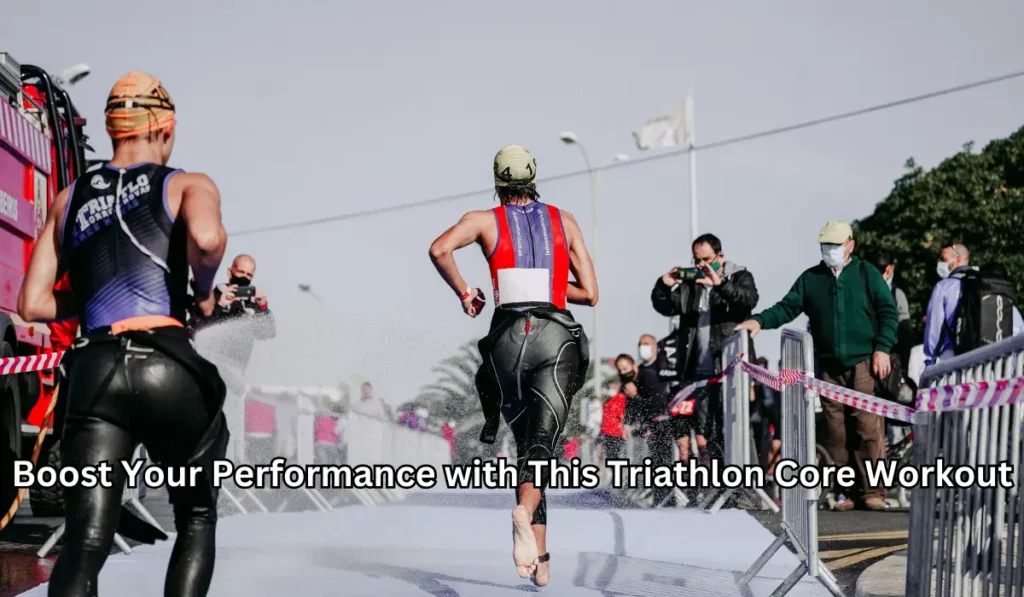
Boost Your Performance with This Triathlon Core Workout
If you’re a triathlete looking to improve your endurance and performance, then you know that a strong core is essential for success. Your core muscles help stabilize your body during the swim, bike and run, making it easier to maintain proper form and prevent injury.
Fortunately, there are a variety of exercises you can do to strengthen your core and take your training to the next level. By incorporating targeted exercises such as planks, crunches, and bridges into your routine, you’ll not only improve your core strength but also enhance your overall fitness.
With a stronger core, you’ll be able to maintain your form for longer periods of time, swim with greater efficiency, bike with more power, and run with more stability. So if you’re ready to up your game and achieve your triathlon goals, be sure to add these core exercises to your training plan.
Importance of Core Strength for Triathletes
Core strength is crucial for triathletes as it plays a significant role in improving endurance and performance. A strong core provides stability and helps maintain proper form during the swim, bike, and run, reducing the risk of injury and enhancing overall efficiency.
During the swim portion of a triathlon, a strong core helps to maintain a horizontal body position, reducing drag and allowing the athlete to swim with less effort. In cycling, a strong core enables the athlete to maintain a stable upper body, increasing pedaling efficiency and preventing back pain. Finally, during the run, a strong core stabilizes the body, reducing the impact on the legs and minimizing the risk of injury.
Moreover, a strong core allows athletes to transfer power more effectively, which can increase overall speed and performance. With improved core strength, triathletes can maintain proper form throughout the race, avoid energy-wasting compensations, and stay more comfortable during the competition. Therefore, triathletes must incorporate core strengthening exercises into their training routine to improve endurance and performance.

Understanding the Core Muscles
The core muscles are the group of muscles that make up the trunk of the body, including the abdomen, lower back, hips, and pelvis. The core muscles are responsible for providing stability and support to the spine and pelvis, facilitating movement, and maintaining proper posture.
The major core muscles include the rectus abdominis (the “six-pack” muscles), the obliques (located on either side of the rectus abdominis), the transverse abdominis (the deepest abdominal muscle), and the erector spinae (the muscles that run along the spine). The hip flexors, glutes, and pelvic floor muscles are also considered part of the core muscle group.
In triathlon, core strength is essential for maintaining proper form during the swim, bike, and run. A strong core enables the athlete to maintain a stable upper body during cycling, reducing the risk of back pain and improving pedaling efficiency. During the run, core strength stabilizes the pelvis and reduces the impact on the legs, preventing injury and improving endurance.
By targeting the core muscles with specific exercises, triathletes can improve their overall strength, stability, and power, enhancing their performance and reducing the risk of injury.
Read about Single Arm Incline Dumbbell Press
The Best Triathlon Core Workout
Effective Exercises for Strengthening the Core
Effective core-strengthening exercises for triathletes include planks, crunches, bridges, and bird dogs.
- Planks are a popular exercise that targets the entire core, including the rectus abdominis, transverse abdominis, and obliques. To perform a plank, start in a push-up position, with your elbows resting on the ground and your forearms parallel to each other. Hold your body in a straight line, keeping your abs engaged and your hips level, for 30-60 seconds.
- Crunches are another effective exercise for strengthening the rectus abdominis. To perform a crunch, lie on your back with your knees bent and your feet flat on the ground. Place your hands behind your head and lift your shoulders off the ground, keeping your lower back pressed into the floor. Lower back down and repeat for 10-15 repetitions.
- Bridges are a great exercise for strengthening the glutes and lower back, which are also important core muscles. To perform a bridge, lie on your back with your knees bent and your feet flat on the ground. Lift your hips off the ground, squeezing your glutes and engaging your lower back. Lower back down and repeat for 10-15 repetitions.
- Bird dogs are a fantastic exercise for targeting the erector spinae, the muscles that run along the spine. To perform a bird dog, start on your hands and knees, with your hands under your shoulders and your knees under your hips. Extend your right arm and left leg straight out, keeping your abs engaged and your back straight. Hold for a few seconds and then switch sides, extending your left arm and right leg. Repeat for 10-15 repetitions on each side.
Instructions for Proper Form and Technique
Proper form and technique are essential when performing core-strengthening exercises to ensure maximum benefit and reduce the risk of injury.
- When performing planks, make sure your elbows are directly under your shoulders and your body is in a straight line from your head to your heels. Keep your abs engaged and your hips level, and avoid arching or rounding your back.
- When performing crunches, avoid pulling on your neck or using momentum to lift your shoulders off the ground. Keep your hands lightly behind your head and focus on using your abs to lift your shoulders up, rather than pulling on your neck.
- When performing bridges, keep your feet hip-distance apart and your knees in line with your hips. Lift your hips up until your body forms a straight line from your knees to your shoulders, and avoid arching your back or overextending your hips.
- When performing bird dogs, keep your abs engaged and your back straight. Focus on reaching your arm and leg out rather than lifting them too high or too far, which can cause the lower back to arch.
Benefits of Each Exercise for Triathletes
- Planks are an effective exercise for strengthening the core muscles, improving stability and endurance, and reducing the risk of injury during triathlon training. By targeting the rectus abdominis, transverse abdominis, and obliques, planks help to improve posture, reduce back pain, and increase overall strength and power.
- Crunches are an excellent exercise for strengthening the rectus abdominis, which is important for maintaining a stable upper body during cycling and reducing the risk of injury during the run. By improving core strength and endurance, crunches can also help to increase speed and efficiency during the race.
- Bridges are a beneficial exercise for targeting the glutes and lower back, which are essential for maintaining proper form and reducing the risk of injury during cycling and running. By improving glute strength and stability, bridges can also help to increase power and speed during the race, particularly during the bike portion.
- Bird dogs are a fantastic exercise for strengthening the erector spinae, which run along the spine and are essential for maintaining proper posture and reducing the risk of back pain. By targeting this muscle group, bird dogs can help triathletes maintain a stable upper body during the bike portion of the race, reducing the risk of injury and improving endurance.
Other Ways to Improve Core Strength
In addition to triathlon core workout exercises, there are a variety of other activities that can improve core strength and stability for triathletes. These include yoga, Pilates, and functional training.
- Yoga is a popular activity among triathletes, as it helps to improve flexibility, balance, and core strength. Many yoga poses, such as the plank, downward-facing dog, and boat pose, target the core muscles and can help to improve overall stability and endurance. In addition, practicing yoga can help to reduce stress and increase mental focus, which can be beneficial during the race.
- Pilates is another activity that can help triathletes improve their core strength and stability. Pilates focuses on strengthening the deep abdominal muscles, which are essential for maintaining proper posture and stability during the race. By improving core strength and stability, Pilates can also help to reduce the risk of injury and improve overall endurance.
- Functional training is a type of exercise that focuses on movements that mimic everyday activities, such as lifting, pushing, and pulling. By incorporating functional training exercises into your routine, you can improve your overall strength and stability, reducing the risk of injury and improving your performance during the race. For example, exercises such as squats, lunges, and kettlebell swings can help to improve glute and core strength, which are essential for maintaining proper form during cycling and running.
Read about Difference Between Crossfit and HIIT
In addition to these activities, it’s important for triathletes to maintain a healthy and balanced diet, as well as get enough rest and recovery time between training sessions. By fueling your body with the right nutrients and allowing time for rest and recovery, you can ensure that your core muscles are able to repair and grow stronger, improving your overall endurance and performance during the race.

Conclusion: Should You Try Triathlon Core Workout?
In conclusion, incorporating a triathlon core workout into your training routine can be incredibly beneficial for triathletes of all levels. A strong core helps to stabilize the body during the swim, bike, and run, improving endurance and performance while reducing the risk of injury. By incorporating targeted core-strengthening exercises, such as planks, crunches, and bridges, into your routine, you can improve overall stability and strength, as well as increase power and speed during the race.
In addition to core-strengthening exercises, activities such as yoga, Pilates, and functional training can also help to improve core strength and stability. By incorporating a variety of activities into your routine, you can ensure that your core muscles are strong and stable, reducing the risk of injury and improving your overall endurance and performance during the race.
If you’re a triathlete looking to take your training to the next level, incorporating triathlon core exercises into your routine is definitely worth considering. With improved core strength and stability, you’ll be able to maintain proper form and reduce the risk of injury, allowing you to train more effectively and achieve your triathlon goals. So go ahead, try a triathlon core workout, and see the difference it can make in your training and performance.